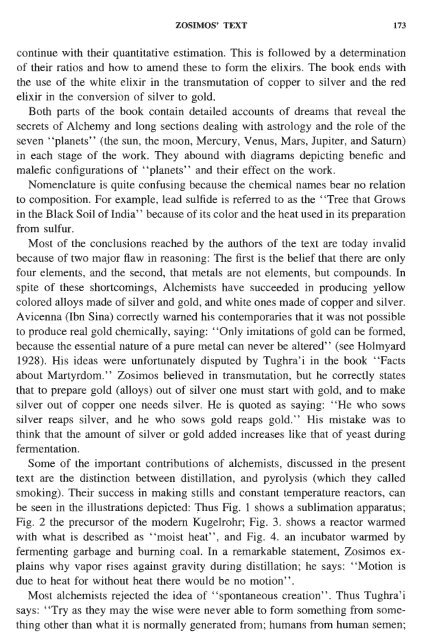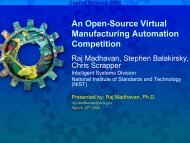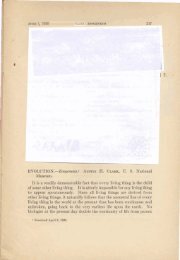A Translation of a Zosimos' Text in an Arabic Alchemy Book
A Translation of a Zosimos' Text in an Arabic Alchemy Book
A Translation of a Zosimos' Text in an Arabic Alchemy Book
You also want an ePaper? Increase the reach of your titles
YUMPU automatically turns print PDFs into web optimized ePapers that Google loves.
ZOSIMOS' TEXT 173<br />
cont<strong>in</strong>ue with their qu<strong>an</strong>titative estimation. This is followed by a determ<strong>in</strong>ation<br />
<strong>of</strong> their ratios <strong>an</strong>d how to amend these to form the elixirs. The book ends with<br />
the use <strong>of</strong> the white elixir <strong>in</strong> the tr<strong>an</strong>smutation <strong>of</strong> copper to silver <strong>an</strong>d the red<br />
elixir <strong>in</strong> the conversion <strong>of</strong> silver to gold.<br />
Both parts <strong>of</strong> the book conta<strong>in</strong> detailed accounts <strong>of</strong> dreams that reveal the<br />
secrets <strong>of</strong> <strong>Alchemy</strong> <strong>an</strong>d long sections deal<strong>in</strong>g with astrology <strong>an</strong>d the role <strong>of</strong> the<br />
seven "pl<strong>an</strong>ets" (the sun, the moon, Mercury, Venus, Mars, Jupiter, <strong>an</strong>d Saturn)<br />
<strong>in</strong> each stage <strong>of</strong> the work. They abound with diagrams depict<strong>in</strong>g benefic <strong>an</strong>d<br />
malefic configurations <strong>of</strong> "pl<strong>an</strong>ets" <strong>an</strong>d their effect on the work.<br />
Nomenclature is quite confus<strong>in</strong>g because the chemical names bear no relation<br />
to composition. For example, lead sulfide is referred to as the "Tree that Grows<br />
<strong>in</strong> the Black Soil <strong>of</strong> India" because <strong>of</strong> its color <strong>an</strong>d the heat used <strong>in</strong> its preparation<br />
from sulfur.<br />
Most <strong>of</strong> the conclusions reached by the authors <strong>of</strong> the text are today <strong>in</strong>valid<br />
because <strong>of</strong> two major flaw <strong>in</strong> reason<strong>in</strong>g: The first is the belief that there are only<br />
four elements, <strong>an</strong>d the second, that metals are not elements, but compounds. In<br />
spite <strong>of</strong> these shortcom<strong>in</strong>gs, Alchemists have succeeded <strong>in</strong> produc<strong>in</strong>g yellow<br />
colored alloys made <strong>of</strong> silver <strong>an</strong>d gold, <strong>an</strong>d white ones made <strong>of</strong> copper <strong>an</strong>d silver.<br />
Avicenna (Ibn S<strong>in</strong>a) correctly warned his contemporaries that it was not possible<br />
to produce real gold chemically, say<strong>in</strong>g: "Only imitations <strong>of</strong> gold c<strong>an</strong> be formed,<br />
because the essential nature <strong>of</strong> a pure metal c<strong>an</strong> never be altered" (see Holmyard<br />
1928). His ideas were unfortunately disputed by Tughra'i <strong>in</strong> the book "Facts<br />
about Martyrdom." Zosimos believed <strong>in</strong> tr<strong>an</strong>smutation, but he correctly states<br />
that to prepare gold (alloys) out <strong>of</strong> silver one must start with gold, <strong>an</strong>d to make<br />
silver out <strong>of</strong> copper one needs silver. He is quoted as say<strong>in</strong>g: "He who sows<br />
silver reaps silver, <strong>an</strong>d he who sows gold reaps gold." His mistake was to<br />
th<strong>in</strong>k that the amount <strong>of</strong> silver or gold added <strong>in</strong>creases like that <strong>of</strong> yeast dur<strong>in</strong>g<br />
fermentation.<br />
Some <strong>of</strong> the import<strong>an</strong>t contributions <strong>of</strong> alchemists, discussed <strong>in</strong> the present<br />
text are the dist<strong>in</strong>ction between distillation, <strong>an</strong>d pyrolysis (which they called<br />
smok<strong>in</strong>g). Their success <strong>in</strong> mak<strong>in</strong>g stills <strong>an</strong>d const<strong>an</strong>t temperature reactors, c<strong>an</strong><br />
be seen <strong>in</strong> the illustrations depicted: Thus Fig. 1 shows a sublimation apparatus;<br />
Fig. 2 the precursor <strong>of</strong> the modem Kugelrohr; Fig. 3. shows a reactor warmed<br />
with what is described as "moist heat", <strong>an</strong>d Fig. 4. <strong>an</strong> <strong>in</strong>cubator warmed by<br />
ferment<strong>in</strong>g garbage <strong>an</strong>d burn<strong>in</strong>g coal. In a remarkable statement, Zosimos ex-<br />
pla<strong>in</strong>s why vapor rises aga<strong>in</strong>st gravity dur<strong>in</strong>g distillation; he says: "Motion is<br />
due to heat for without heat there would be no motion".<br />
Most alchemists rejected the idea <strong>of</strong> "spont<strong>an</strong>eous creation". Thus Tughra'i<br />
says: "Try as they may the wise were never able to form someth<strong>in</strong>g from some-<br />
th<strong>in</strong>g other th<strong>an</strong> what it is normally generated from; hum<strong>an</strong>s from hum<strong>an</strong> semen;







